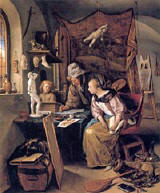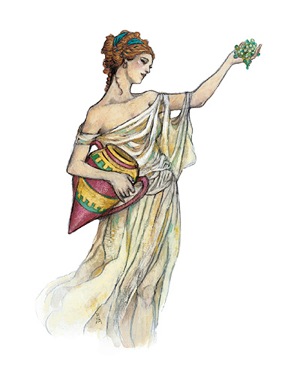LETTERS FROM THE GLOBAL PROVINCE
Global Province Letter: A House Is Not a Home
February 24, 2010
Valentinos. Good-hearted sorts in these United States send about 7 billion greeting cards a year to family, cherished friends, and, we suppose, barely known acquaintances they have met on Facebook. Major holidays and birthdays account for the lion’s share of these expressions of warmth, but Valentines, we are told, are not far behind. Indeed, it’s cheering to bump into whole families in the aisles of a neighborhood drug store carefully picking out heart-strewn cards that will signal their strong affections for and speak to the character of their recipients. The sending of mass-produced cards dates back to the 19th century, though exchanges of gifts and personal notes have a much longer history.
 At every excuse, we send out a surfeit of such billet doux. But we’re even given to further excess when it comes to holidays, no matter the occasion. For February 12 this year, we conjured up Valentinos, heart-shaped pastries or toasts that are so flavorful that they don’t require the unctuous quantities of maple syrup we apply to ordinary French toast. As a chaser, we inhaled a shot glass full of pomegranate-infused, chilled vodka, doubly insuring that we spared ourselves the tiresome oatmeals and all the other health-giving, visually distasteful substances people like Mayor Bloomberg and skinny fashion models in Manhattan ingested, at the same time, during Fashion Week in New York City. The fire behaved itself that morning, intensifying the red blush in our faces: even our green wood burnt brightly because we had stoked it with so much kindling. February’s unkind winds had put a lot of branches on the ground, and they added gusto and crackling sounds to our homey fireplace.
At every excuse, we send out a surfeit of such billet doux. But we’re even given to further excess when it comes to holidays, no matter the occasion. For February 12 this year, we conjured up Valentinos, heart-shaped pastries or toasts that are so flavorful that they don’t require the unctuous quantities of maple syrup we apply to ordinary French toast. As a chaser, we inhaled a shot glass full of pomegranate-infused, chilled vodka, doubly insuring that we spared ourselves the tiresome oatmeals and all the other health-giving, visually distasteful substances people like Mayor Bloomberg and skinny fashion models in Manhattan ingested, at the same time, during Fashion Week in New York City. The fire behaved itself that morning, intensifying the red blush in our faces: even our green wood burnt brightly because we had stoked it with so much kindling. February’s unkind winds had put a lot of branches on the ground, and they added gusto and crackling sounds to our homey fireplace.
Such detailed preparation, imaginative celebration, and prolonged consummation are, in our eyes, the essence of a holiday. Without hullabaloo and a lot of commotion, a holiday is just another day. It’s not enough that an event bear our mere signature: gladness arises when our very distinctive imprimatur colors each of our experiences.
Domestic Bliss. St. Valentine’s Day, Pope Gelasius I’s 496 A.D. remembrance of Christian martyrs, now sadly removed from the Roman Catholic Church’s calendar of saints, can best remind us now that the very purpose of our own republic is to achieve domestic bliss, a state of being that’s elusive in the present day. Our Constitution’s preamble calls for a “more perfect union” and “domestic tranquility.” But military haute couture now envelops our flak-jacket, leggy, emaciated fashion models, just one reminder of many that armed conflict and a terrorized state of mind are persistent low-grade viruses that infect the whole planet, with no respect for borders. Acerbic diatribes in legislatures and bombast in our media have chased harmony from our nation’s hallways. All this, even though researchers aplenty attest, again and again, that happiness and good cheer are so intimately involved with our health and our prosperity. Rancor is ultimately a very bad business, yet today agitation and distress are standard daily fare.
Amidst this sea of dysfunction and conflict, our best hope for happiness is to get things straight in our own households, the arena where we can most assert our good will and our values. Helpless we may be in confronting the ills of society, but we can reconstruct ourselves behind our front door, at the dinner table, or in the rambling garden. This is a central assumption, often missed, of Epicureanism. That is, we can bless our lives and our minds if we closet ourselves behind the garden wall where affinity can reign.
“The school of Epicurus, called "The Garden," was based in Epicurus' home and garden. It had a small but devoted following in his lifetime. Its members included Hermarchus, Idomeneus, Colotes, Polyaenus, and Metrodorus. Epicurus emphasized friendship as an important ingredient of happiness, and the school seems to have been a moderately ascetic community which rejected the political limelight of Athenian philosophy. They were fairly cosmopolitan by Athenian standards, including women and slaves, and were probably vegetarians.”
The question for us is whether we can create enough domestic warmth in our abodes to exclude the stresses of the political and commercial marketplace. If we can get the home fires burning brightly enough, we might even chance to push back the dark moods and antagonistic behaviors that have turned daily intercourse into verbal warfare.
Domestic Novels. This is easier said than done. Households have lost the art of domesticity. After all, 50% of all marriages in America culminate in divorce. A visit to most families finds every parent and every child so obsessed by over-stuffed schedules and copious activites that they have few moments for utter leisure and idyllic, wandering conversation. A walk-through of a neighbor’s house uncovers cookie-cutter French provincial bedroom furniture and chrome track lighting that mimics furnishings in houses east, north, west, and south. Home economics, once taught widely at schools and colleges, has largely disappeared from our lexicon, and is much despised as a tool to enslave women. In other words, the lineaments of domesticity are missing. The particularity is absent which separates one’s home from the world outside.
We’re reminded, in this regard, of the bumptious madam Polly Adler whose school thesis turned into a book called A House is not a Home. Now we must all figure out how to turn houses into homes that are not knockoffs but one-of-a-kinds. We theorize that the Hollywood Madam would escape notoriety and achieve happiness if only she understood the distinction. She’s a vegetarian, yet another self-defacing behavior we would hope she could leave behind.
Our own research has drawn us to 20th century domestic novels that at least capture memories of times when unique domestic doings filled out the day. Kazuo Ishiguro’s Remains of the Day illuminates a pre-World War II English upper class household. It focuses on the rituals of servants, particularly Mr. Stevens, the butler, and it lays out the loyalties, the conscientiousness, and the sacrifices that once made a well-ordered domestic life the centerpiece of society. That’s lost by war’s end.
The novels of Angela Thirkell cover some of the same space, looking at small village England in the first half of the century. Her Private Enterprise also opposes a companionable domestic existence where different households together achieve a general happiness to, in contrast, earth-shattering World War II and especially its aftermath where big government, war’s privations, and the disintegration of Empire undermined life as it was. In some measure both novels sketch for us the host of practices that once guaranteed domesticity and pre-figured our present homelessness.
Household Hints. The great domestic San Francisco architect Bernard Maybeck once said that he knew he’d built the right house for a client if the owner then went on to successfully landscape the dwelling, making the outside as felicitous as the inside, achieving a harmony with the whole. Good plantings and successful gardening are certainly one aspect of a radiant household. Certainly it’s a series of small atmospheric things, not one big thing, that affords us domestic transquillity.
With the Dutch, masters of domestic genre paintings, and with our own 19th century idyllic artists, we learn that it is not compelling monumental content, but a series of small touches that put home into a house. Perhaps it is two dogs before the fire. Or a mother working on a quilt. In any event, what is portrayed excludes the brittle realities of the outside world and paints in effects minor enough in scale that they do not obscure the central family scene. In every sense, domesticity is counterpoint to the world of great doings, not an extension of it. As the great interior designer John Saladino is wont to say, “Every home should be a sanctuary: entering it you should immediately feel physically and emotionally protected.” The word “comfortable” comes to mind. Seen in this light, the challenge of interior design is not to create theater or grand scenes, but to complement the virtues and voices of the family inhabiting a house.
we learn that it is not compelling monumental content, but a series of small touches that put home into a house. Perhaps it is two dogs before the fire. Or a mother working on a quilt. In any event, what is portrayed excludes the brittle realities of the outside world and paints in effects minor enough in scale that they do not obscure the central family scene. In every sense, domesticity is counterpoint to the world of great doings, not an extension of it. As the great interior designer John Saladino is wont to say, “Every home should be a sanctuary: entering it you should immediately feel physically and emotionally protected.” The word “comfortable” comes to mind. Seen in this light, the challenge of interior design is not to create theater or grand scenes, but to complement the virtues and voices of the family inhabiting a house.
There are economic lessons to be learned here. We have said elsewhere that developed nations cannot compete with emerging nations in either goods or services, if the main criterion is cost. But they can do custom, one-of-a-kind products better. What better place to learn uniqueness than at home. By putting sanctified ‘thereness’ in a house and ridding it of ‘everywhereness,’ we learn the art of the particular. Our escape from the mass production society had best begin in this way at home. Not only our home life, but also our economy, require a new consciousness.
The Restoration. We have often made reference to Neil Postman’s Building a Bridge to the 18th Century: How The Past Can Improve Our Future. If we could reclaim some parts of the 18th, he would say, our 21st would be a lot better. In Appendix III, he probably nails down what we may have most lost in the present—homelife and childhood. “The idea of childhood is one of the great inventions of the Renaissance, perhaps its most humane one. Along with science, the nation-state, and religious freedom, childhood as both a social principle and a psychological condition emerged around the seventeenth century.”
“Childhood was an outgrowth of literacy” and the printing press. “In less than one hundred years after the invention of the printing press, European culture became a reading culture. One could not become an adult unless one knew how to read.” “What this came to mean in the seventeenth century is that the young had to be separated from the rest of the community to be taught how to read.” Now things are decidedly different. “To summarize, television,” and he might add all our electronic communications which have become primarily visual, “erases the dividing line between childhood and adulthood in two ways: It requires no instruction to grasp its form, and it does not segregate is audience..” The reason for childhood has disappeared, along perhaps with childhood itself.
Is it not fair to say that with technology—TV, the cellphone, the computer, iPods, and the like—we have dissolved the borders between adulthood and childhood, between home and marketplace—that are at the heart of domesticity? Can we put up some walls again? Technology is like our Toyotas—it permits us to go far and fast, but it may just run us off the road.
 P.S. “Hestia, Greek Goddess of the sacred fire, was once known as ‘Chief of the Goddesses’ and ‘Hestia, First and Last’. She was the most influential and widely revered of the Greek goddesses.
P.S. “Hestia, Greek Goddess of the sacred fire, was once known as ‘Chief of the Goddesses’ and ‘Hestia, First and Last’. She was the most influential and widely revered of the Greek goddesses.
“Though the goddess Hestia was once the most important of the Greek goddesses, she (like her counterpart, the Roman goddess Vesta) is virtually unknown today. Her name means “the essence”, the true nature of things.”
P.P.S. Scripps Howard is just about to throw its Fine Living Network to the wolves, since ad dollars will flow to foodie programming, but not to the genteel life. In addition to its food channel, it will now have a cooking channel. Cheerleaders for the compleat home are few and far between, so it will not be an easy to bring back domesticity. Monomania is more the fashion.
P.P.P.S. We welcome suggestions from those of you who have ideas on how to return to the 18th century and recapture domesticity. It’s pleasing to find blogs about that explore that notion.
Home - About This Site - Contact Us
Copyright 2009 GlobalProvince.com